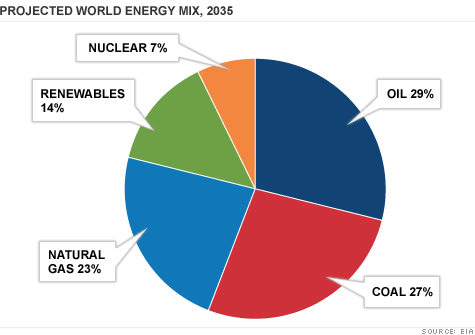Search News

The Energy Information Administrations says jump in energy use is expected to be driven largely by places like China and India. Renewable energy to grow the most, but fossil fuels still dominate.
NEW YORK (CNNMoney) -- Global energy use is expected to jump 53% by 2035, largely driven by strong demand from places like India and China, according to a report Monday.
Combined, developing nations currently use slightly more energy than those in the developed world, according to the U.S. government's Energy Information Administration. By 2035, they are expected to use double.
"Concerns about fiscal sustainability and financial turbulence suggest that economic recovery in the [developed] countries will not be accompanied by the higher growth rates associated with past recoveries," the report said. "In contrast, growth remains high in many emerging economies, in part driven by strong capital inflows and high commodity prices."
The 53% rise is slightly more than the 49% increase the agency predicted in last year's report.
Accompanying the surge in energy use is a correspondingly large jump in greenhouse gas emissions. EIA sees energy-related carbon dioxide emissions rising 43% by 2035.
The projections, in the agency's 2011 International Energy Outlook, are based on current policies. They could change substantially if countries like the United States and China passed stronger laws restricting carbon dioxide emissions.
Higher or lower energy price projections can also influence the report's findings.
EIA assumed slightly lower oil prices in calculating this year's report. The agency predicts oil prices to reach $108 per barrel in 2020 and $125 per barrel in 2035.
Last year EIA thought oil would be at $133 a barrel by 2035. EIA's numbers do not include price increases attributed to the normal rise in inflation.
Fossil fuels will continue to be the dominant fuel choice in 2035, the agency predicts, with renewables constituting just 14% to the world's overall energy consumption.
But that's a substantial jump from renewable energy consumption in 2008, which stood at 10%. That growth rate makes renewables the fastest growing of all the energy sources, the report said.
The agency noted that most future renewable energy supply will continue to come from wind and hydropower. It did not include biofuels like ethanol as part of its renewable catalog, instead lumping it in with liquid fuels like oil.
EIA does not expect solar power to become a significant energy source by 2035. That runs counter to the opinion of solar power supporters who foresee rapidly declining prices for solar panels in the coming years.
The agency predicts nuclear power will go from about 5% of overall energy consumption in 2008 to about 7% in 2035. The vast majority of new nuclear plants are expected to be built in China. EIA did not factor in how last year's nuclear disaster in Japan might impact nuclear power plant construction.
Natural gas continues to make up nearly a quarter of the world's energy consumption, driven by increasing development of shale gas.
EIA projections for natural gas use by 2035 are 8% higher in this year's report compared to last year's, largely due to shale gas development.
Natural gas from shale, which is found in a different type of rock than most previous natural gas developments, has grown rapidly in recent years thanks to new drilling and extracting technology.
The technology involves cracking the shale rock with pressurized, water, sand and chemicals -- a process knows as hydraulic fracturing, for "fracking" for short.
But the process has many people concerned over its effects on the groundwater, and shale gas development has been put on hold or stopped in some locations.
Despite the concerns, EIA predicts shale gas and other unconventional forms of natural gas will make up three quarters of U.S. natural gas production by 2035, up from about half today. Similar patterns are expected in China and Canada. ![]()
| Index | Last | Change | % Change |
|---|---|---|---|
| Dow | 32,627.97 | -234.33 | -0.71% |
| Nasdaq | 13,215.24 | 99.07 | 0.76% |
| S&P 500 | 3,913.10 | -2.36 | -0.06% |
| Treasuries | 1.73 | 0.00 | 0.12% |
| Company | Price | Change | % Change |
|---|---|---|---|
| Ford Motor Co | 8.29 | 0.05 | 0.61% |
| Advanced Micro Devic... | 54.59 | 0.70 | 1.30% |
| Cisco Systems Inc | 47.49 | -2.44 | -4.89% |
| General Electric Co | 13.00 | -0.16 | -1.22% |
| Kraft Heinz Co | 27.84 | -2.20 | -7.32% |
| Overnight Avg Rate | Latest | Change | Last Week |
|---|---|---|---|
| 30 yr fixed | 3.80% | 3.88% | |
| 15 yr fixed | 3.20% | 3.23% | |
| 5/1 ARM | 3.84% | 3.88% | |
| 30 yr refi | 3.82% | 3.93% | |
| 15 yr refi | 3.20% | 3.23% |
Today's featured rates: